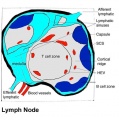File:Lymph node structure 02.jpg: Difference between revisions
From Embryology
| Line 2: | Line 2: | ||
Schematic representation of the organization of a lymph node. | Schematic representation of the organization of a lymph node. | ||
* '''Afferent lymphatics''' enter lymph nodes and deliver lymph to the subcapsular sinus (SCS), which forms a channel around the periphery of the lymph node. | * '''Afferent lymphatics''' enter lymph nodes and deliver lymph to the '''subcapsular sinus''' (SCS), which forms a channel around the periphery of the lymph node. | ||
* '''Lymphatic sinuses''' run from the SCS through the cortex to the medulla | * '''Lymphatic sinuses''' run from the SCS through the cortex to the medulla | ||
* '''Efferent lymphatics''' exit the lymph node via efferent lymphatic vessels on the opposite (hilar) side of the organ. | * '''Efferent lymphatics''' exit the lymph node via efferent lymphatic vessels on the opposite (hilar) side of the organ. | ||
Revision as of 12:10, 25 February 2012
Lymph Node Structure
Schematic representation of the organization of a lymph node.
- Afferent lymphatics enter lymph nodes and deliver lymph to the subcapsular sinus (SCS), which forms a channel around the periphery of the lymph node.
- Lymphatic sinuses run from the SCS through the cortex to the medulla
- Efferent lymphatics exit the lymph node via efferent lymphatic vessels on the opposite (hilar) side of the organ.
- High endothelial venules (HEVs) - in the paracortex and cortical ridge, specialized vessels allow entry of leukocytes from the blood.
- Blood vessels enter and exit the lymph node on the hilar side, and snake through the lymph node like the branches of a tree.
- B cell follicles containing follicular dendritic cell (FDC) networks are arranged in the lymph node cortex and are separated from the SCS by a layer of marginal reticular cells (MRC).
- T cells zones in the paracortex, which contain many fibroblastic reticular cells (FRC), are separated by the cortical ridge, an area rich in T cells, dendritic cells (DCs), blood vessels, and FRC.
Scale bars represent 200 μM.
- Lymph Node Cartoons: Detailed structure | Cartoon with Histology | Lymphocyte traffic | Simple structure | Simple node anatomy | Wiki node image | Internal structure | Mesenteric lymph node | Histology | Gallery | Lymph Node Development
Reference
<pubmed>19644499</pubmed>| PMC2785037 | Nat Rev Immunol.
File history
Click on a date/time to view the file as it appeared at that time.
| Date/Time | Thumbnail | Dimensions | User | Comment | |
|---|---|---|---|---|---|
| current | 18:53, 22 February 2012 |  | 460 × 463 (54 KB) | Z8600021 (talk | contribs) | ==Lymph node structure== Schematic representation of the organization of a lymph node (left panel). Afferent lymphatics enter lymph nodes and deliver lymph to the subcapsular sinus (SCS), which forms a channel around the periphery of the lymph node. Lymp |
You cannot overwrite this file.
File usage
The following 4 pages use this file: